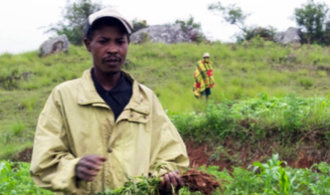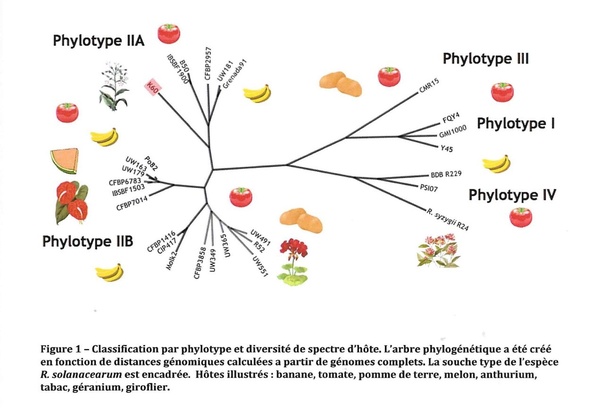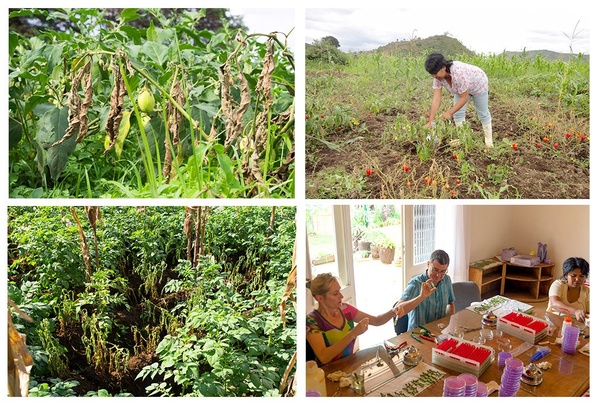Active epidemiological surveillance of Bacterial wilt in the Indian Ocean
Written by Modified on the
Ralstonia solanacearum is a bacterium responsible for the wilt of a large number of cultivated and wild plants worldwide. Some strains of this bacterium are recognized as a quarantine pest in Europe and potential bioterrorism agent in the US. R. solanacearum can cause the loss of an entire crop and usually leads to the death of the plant.
The only way to fight against this plant pathogen, whether endemic or introduced, is to use resistant crop varieties. To control this highly adaptable bacterium, CIRAD research teams and the University of Reunion Island are working tirelessly with their Indian Ocean partners to better understand the disease and to study the available resistant varieties.
An exceptional capacity to adapt
Affecting more than 250 species in 50 plant families around the world, R. solanacearum is responsible for bacterial wilt, considered one of the most harmful diseases in the world for food production. Particularly active in tropical and subtropical areas, it causes heavy losses in crops of economic importance such as potatoes (brown rot or bacterial potato wilt), banana (blood disease, Moko disease,etc.), tomato (bacterial wilt disease), eggplant or anthurium. Found in the rhizosphere at the interface between the soil and roots, it penetrates through the roots and colonizes the vascular tissue of the plant, causing it to decay. Wilt is caused by a blockage of the flow of raw sap in the plant. Its high pathogenicity combined with the fact that it is extremely opportunistic make R.solanacearum a particularly formidable and complex disease. It has a remarkable adaptability which results in a large genetic variability within the same species. A strain can infect a broad range of hosts while another will attack only one plant species.
A complex of species belonging to 4 genetic lineages
To better understand, predict and limit the adaptation process, bacteriologists led by Philippe Prior are trying to obtain precise information about the bacterium’s diversity and its interactions with the plants that it infects. The research is largely based on genetic analyses which determine the origin of the strains present. The species is divided into four lineages correlated with their geographical origin :
• lineage I originated from Asia ;
• lineage II comes from the Americas. This is the strain called II-B1 and is the subject of strict epidemiological surveillance in countries where it has pest quarantine status ;
• lineage III originated from Africa ;
• lineage IV comes from Indonesia.
At the beginning of 2015, research conducted in Reunion Island and in various parts of the world has brought together these lineages in three species, phylotypes I and III being found within the same group. However, this division is helped by another useful feature to describe the ecological diversity within a species: the ecotype. Indeed, the researchers found that in some geographically isolated areas, some strains, although genetically identical, might infect new hosts. The study of this characteristic is particularly important in agronomy, because it helps understand how the bacteria adapts to the host, allowing scientists to develop more effective diagnostic tools and better manage resistant varieties.
Epidemic bacterial blight in Madagascar, a thesis to help us better understand
The southwestern islands of the Indian Ocean are not spared from this disease. Groups of strains I, II and III have all been identified in the region. In 2009, a severe epidemic of bacterial blight hit Madagascar, causing the contamination of all potato production areas and seed production stations. A thesis funded by the Région Réunion began in 2013 as part of EPRPV project to research the source and the mechanisms that led to the epidemic and to find varieties of potato resistant to the disease. The thesis, by Santatra Ravelomanantsoa under the direction of Philippe Prior, has three objectives. The first one is to study bacterial diversity using molecular methods to determine which strains are involved. To this end, Santatra has collected 1224 strains from 74 production sites.
The results showed the presence of strains from groups I, II and III but the vast majority of strains were from lineage II, specifically Group IIB-1, responsible for brown rot (blackleg disease). This discovery is significant because only I and III strains had previously been identified in Madagascar. These initial results suggest that the outbreak was caused by the introduction of a new strain of R. solanacearum.
The second objective is to predict the evolutionary mechanisms of the bacteria using methods such as phylogeny and population genetics. The third objective of the thesis is to characterize the pathogenicity, and thus the virulence and aggressiveness, of the strains identified. Resistant varieties of potatoes will be tested and will be made available to farmers in order to control the disease depending on the strains present. The highly harmful bacteria will be handled in a quarantine level 3 laboratory (NS3) at the Plant Protection Platform in Reunion Island. The varieties selected will be tested in controlled and natural environments (Madagascar, southwest Indian Ocean islands and East Africa).
Other work is being done on this bacterium, including the thesis of Noura Yahiaoui, started in 2014 under the joint supervision of CIRAD and ANSES in Reunion Island, which has focused on the epidemiological surveillance of R. solanacearum in Reunion and the islands the SWIO.
The IIB-1 strain: a highly virulent but controllable bacterium
Work on bacterial blight of potato in Madagascar highlights the threat of the IIB-1 strain. Despite its virulence, this bacterium can be controlled by reducing infection in tubers across the island. Luckily, this group of strains only survives a short time in the ground without the host plant. The contamination mainly comes from infected tubers distributed to farmers. According to Philippe Prior, wherever an outbreak was recorded, seed production supply chains were infected, allowing the bacteria to spread. Because of the virulence of the strain, which can also be introduced by other host plants such as anthurium or geranium, anywhere where potato seeds are produced needs to be equipped with reliable diagnostic tools and impose strict monitoring protocols to detect the slightest trace of the disease. These precautions, while binding, are essential to protect sensitive crops such as potato and tomato, from the havoc that can be wreaked from the introduction or spread of R. solanacearum.
In conclusion, this is a struggle between Man (breeders, pathologists and farmers) and Nature that, through this global bacterium, has demonstrated a remarkable ability to adapt. Ancestral pathogen, R. solanacearum probably remains endemic in its original environment, in equilibrium in plant reservoirs. Intensive agricultural practices involving the planting of varieties which are often clonal, and over large areas, may have contributed to its extraordinary genetic explosion. The work done by breeders to improve the resistance of commercial varieties must be conducted with care to prevent further adaptation of the bacteria and a circumvention of resistance. Preserving natural biodiversity is critical to protect sources of resistance / tolerance in wild species, but also to avoid modifying the balance of nature in order to limit the emergence of new and more aggressive strains.





